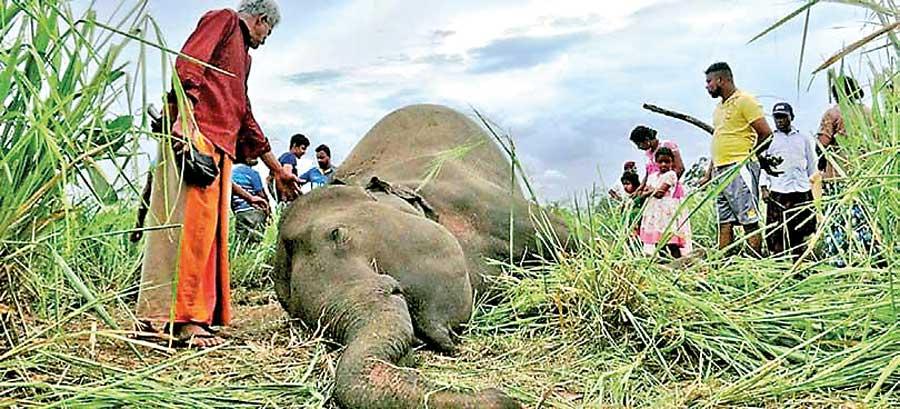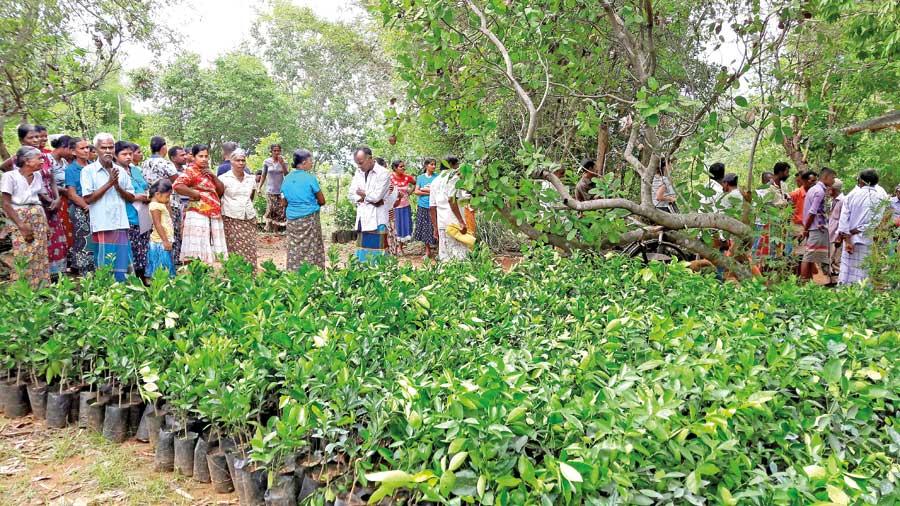Reply To:
Name - Reply Comment

Sri Lanka is a blessed land with gentle giants roaming its territory and the Blue Whale occupying its waters. Or so we think. With increased number of humans encroaching into wildlife abundant habitats, especially those frequented by elephants, they have become internally displaced within their home ground. As a result, the Human-Elephant Conflict (HEC) has aggravated over the years, killing as many as 349 elephants in 2019 alone. While elephant experts are advocating for change by spending long hours on the field and suggesting sustainable solutions, the newly appointed Minister of Wildlife, Environment, Land and Land Reclamation S. M Chandrasena - the authority figure that can take decisions pertaining to his subject areas, came under heavy scrutiny and criticism following some short-sighted decisions taken as means of controlling HEC.
While visiting intense HEC affected areas including Wilachchiya, Thalawa, Galnewa and Nochchiyagama inearly December, Minister Chandrasena opined that there has to be a permanent solution for the issue. “People are suffering from damages to their cultivations and property,” he said while addressing the media. “During the past years no subject Minister has taken actions against this escalating issue. I have also heard that the DWC is severely understaffed and doesn’t have many vehicles. Sri Lanka can only hold 3000 elephants but there are 6000 of them.”A few days after the Minister made this statement, the Civil Defence Force was armed with 2000 guns as means of keeping elephants at bay in HEC affected areas.
Both issues were received by animals rights activists and wildlife organizations with much discontent. A statement issued by the Wildlife and Nature Protection Society of Sri Lanka stated that the inaugural distribution of 2000 (two thousand) 12 gauge shotguns (firearms) and S.G cartridges to members of the Civil Defence Force who are expected to deal with crop raiding elephants in farmlands and is seen as a part solution to HEC. “The WNPS believes and cautions that this action is going to exacerbate rather than mitigate HEC in these areas, where Civil Defence Cadres are being given additional firearms. The WNPS would like to draw the kind attention of the Minister, his Ministry officials and the Director General of wildlife and his officers to the fact that, the spherical led pellets of .32 calibre (9 in each cartridge) when fired at an elephant at close range can penetrate the animals skin, fat and muscle layers and reach vital organs. In such cases, with a well placed shot, death of the elephant will be the outcome. At a distance of 50 metres, these pellets will retain enough velocity and energy to penetrate the thick skin layers of an elephant and lodge against bone or enter muscle tissue. In most instances the wounds sustained by these gunshots will result in the eventual death of the elephant. The resultant death will be lingering and painful, with suppurating wounds or abscesses, infections and debilitating illness. Meanwhile, these elephants in their pain and anger will become extremely dangerous to humans they encounter until they eventually weaken and succumb to the complications caused by gunshot wounds.”
"People are suffering from damages to their cultivations and property - Chandrasena"
Another statement issued by the Federation of Environmental Organisations (FEO) states that in 2019, in Sri Lanka, as per official figures and as highlighted in the media worldwide, 386 wild elephant deaths were recorded of which just 37 were due to natural causes. “The rest were due to human – elephant conflict, by far the highest number to be reported since 1948. Ironically, elephants are a valuable financial asset to this country, not dead but alive. In 2016, as per a study conducted by the Sri Lanka Association of Inward Tourism Operators (SLAITO), Rs.1.25 billion was generated for the local economy by the Minneriya National Park alone – all to see elephants. In the same year, the Yala National Park made Rs.7.5 billion. President Gotabaya Rajapaksa won an overwhelming victory at the recent election. One of the main reasons for this was his promise that he would employ technocrats and scientists to help formulate and direct policies. Conservation in Sri Lanka desperately needs such policies. Alas, the Minister does not seem to think so. Ultimately, what is the legacy that this political administration wish to leave posterity? The politically orchestrated massacre of a globally endangered species, the Sri Lankan elephant? And of those other species killed as collateral? Surely not.”

As many as 349 elephants were killed last year as a result of HEC
Successive ministers who have taken up the subject of Wildlife have made minimal attempts to serve justice to flora and fauna. While deforestation, illegal capturing of endangered species and other activities happen in broad daylight, conservation approaches for endangered and critically endangered species, training for DWC officials, safari jeep operators, Park wardens, surveys on IUCN Red listed flora and fauna never happens at state level. Whether this is due to lack of resources, infrastructure or experts in the field remains a doubt. When Minister Chandrasena assumed duties animal rights activists and wildlife experts have watched his actions with much fury. When the Daily Mirror contacted the Minister to inquire about his statement and decision to deploy weapons, he assured that the weapons will not be used for any illegal activities. “The officers will be closely monitored. We issued weapons to provide assistance to the villagers because they are forever lamenting on their losses. The officers have to use their weapons with discipline.”
When asked about his statement on the 3000 elephants he reiterated that Sri Lanka’s land area has a capacity to hold only that many elephants. “But we can’t kill the excess number. Therefore we will put up man-made lakes and grasslands inside forests for them to roam around and feed on.”
"But we can’t kill the excess number. Therefore we will put up man-made lakes and grasslands inside forests for them to roam around and feed on - Chandrasena"
On January 22, several environmental groups met with Minister Chandrasena and after a round of constructive talks, the Minister had agreed to issue a directive which would request the relevant authorities to refrain from providing more guns to the Civil Defence Force (CDF). The Minister had also agreed to review the Human Elephant Conflict (HEC) mitigation strategy. However it still remains a verbal decision with no action as yet.
“Historically, elephants are iconic and sacred in our land and afforded every legal protection,” opined nature lover and environmental architect Sunela Jayawardena. “Therefore, it is shocking that the government should distribute firearms as protection to farmers in HEC zones - this can only be interpreted as an open reason to kill elephants and any other wildlife, in a country that markets itself as a wilderness destination! Unless these 2000guns are withdrawn immediately, the damage that will be done to our revenue generating wildlife and the image of Sri Lanka as an eco-tourism destination, will be irreversible.”
"It is shocking to see the govt distribute firearms as protection to farmers in HEC zones - this can only be interpreted as an open reason to kill elephants and other wildlife -Sunela Jayawardena"
Over the years, several solutions have been suggested to keep elephants from visiting their habitats which were encroached by humans. For years, government authorities had tried to put electric fences that had no electricity. Over the years, elephants destroyed these fences and moved towards populated areas. Another option was putting up beehive fences similarly to an approach taken to chase away African elephants. But those working on the field claim that that too isn’t a viable solution. “The Sri Lankan honey bee (Apis cerana) is not aggressive enough,” opined Ravi Corea, President of Sri Lanka Wildlife Conservation Society. “They don’t swarm around if an outside threat is detected. Therefore they are not a deterrent. However, the wasps found in Sigiriya are highly aggressive but unfortunately they cannot be collected or used in other areas of the country.”
“Since 2006, we have been planting orange (Citrus aurantium) trees as a pilot project in Wasgamuwa area and the results have been far-reaching,” he continued. “We have been working with 437 farmers in 27 villages and have planted close to 18,500 trees so far. Farmers have experienced a drastic reduction in damage done to their crops. The orange trees have also safeguarded their houses and home gardens as well. We have observed multiple benefits from orange trees. It contributes to climate change, the blossoms have an added benefit of pollinating other crops and oranges have a market value.”
According to Corea, elephants don’t come anywhere near the trees. “Orange trees don’t attract elephants as a food plant. Therefore they would only be seen loitering around these trees or near houses. The project was done in Wasgamuwa and we want to fine tune it. Oranges have been developed to fit any climate and therefore it could be piloted in other parts of the country as well. We are now looking at introducing value- added products to the market. The farmers’ concern is damage to crops. So if they have an alternative income, they need not worry too much. In order to take this project to other parts of the country we need a substantial amount of logistical requirements. But if the Mahaweli Authority and other interested parties are willing to help us, we are happy to take it forward.”
"Orange trees don’t attract elephants as a food plant. Therefore they would only be seen loitering around these trees or near houses - Ravi Corea"
In a memorandum passed in February 2006 titled ‘Preparation of a National Policy for Wild Elephants – Department of Wildlife Conservation’, the Cabinet of Ministers by Cabinet Paper CP06/0367/221/004 granted approval to prepare a National Policy for Conservation of Wild Elephants.
Highlights of the Policy are as follows :

Orange plants given to villagers in Wasgamuwa. Pic courtesy: SLWCs